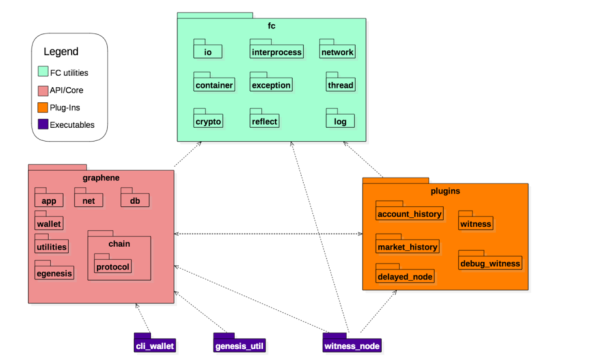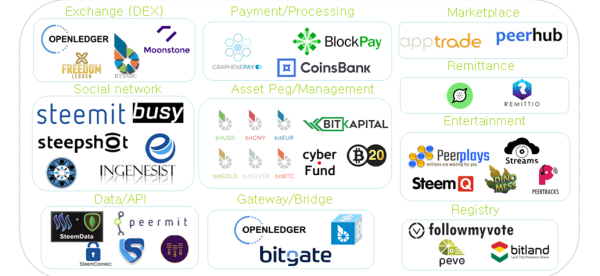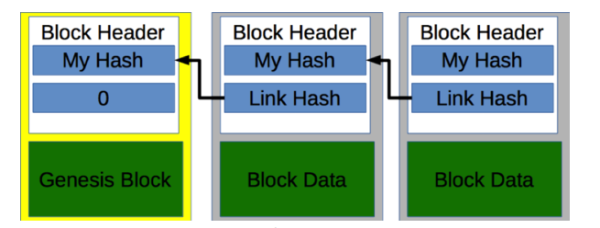A closer look at Steemit's Graphene blockchain
steemit·@bssman·
0.000 HBDA closer look at Steemit's Graphene blockchain
By now, most of us know that the Steemit blockchain uses the delegated Proof of Stake model. This is a consensus mechanism that instead of mining, like bitcoin or other Proof-of-Work systems, delegates are chosen by the stakeholders of the Steem tokens. These delegates (witnesses) proceed to run the network with less competition and energy than bitcoin or Proof-of-Work system. source code packages distributed with Graphene  [Source](https://objectcomputing.com/resources/publications/sett/march-2017-graphene-an-open-source-blockchain/) Today, I want to talk about Graphene, the blockchain technology that steemit runs on. Graphene was developed using for most parts... C++. It is completely open source. It was developed in a modular fashion, making it adaptable to many different uses. Historically, It was originally developed as the foundation of Bitshares which is a cryptocurrency exchange marketplace. Other blockchain that use graphene include PeerPlays blockchain and Golos blockchain. The original Graphene release is managed by an organization known as Cryptonomex. Graphene Ecosystem  [Source](https://followmyvote.com/understanding-the-graphene-blockchain-ecosystem/) **Understanding the blockchain** The blockchain has been defined many times. There are many videos you can watch that will explain it well. For simplicity sake, Fortune.com defines it as: >The blockchain is actually a way to structure data, and the foundation of cryptocurrencies like Bitcoin. This coding breakthrough—which consists of concatenated blocks of transactions—allows competitors to share a digital ledger across a network of computers without need for a central authority. No single party has the power to tamper with the records: the math keeps everyone honest. Forty of the world’s top financial firms are experimenting with the tech. Some terms that we should know include: **Genesis block** This is basically the first block in the chain. It is created when a blockchain is first deployed, serving as the keystone to which all other blocks link. **Block** This is a container of data relevant to this blockchain. The data is typically a collection of transactions that describe changes to the data. These could be records of transfer of assets from one owner to another, or could be the record of some personal information being updated. blocks may contain many or a few transactions. Blocks also contain a header which holds certain meta-information about the block, including a reference to the preceding block.  [Source](https://objectcomputing.com/resources/publications/sett/march-2017-graphene-an-open-source-blockchain/) **Transaction** This is a record of a change to the data set. They are typically based on rules defined by the blockchain. These rules comprise contracts between parties **Node** This is host in a network that is capable of adding blocks to the chain. The way Nodes are able to do this will vary based on the needs of the chain. **Witness** As with the steemit witnesses, this is a node in a DPoS blockchain that performs the task of creating new blocks. **Proof of stake** This is consensus strategy that depends on nodes which hold collateral to participate in contributing blocks to the chain. Proof of stake, allows blocks to be added to the chain more quickly. **Delegated proof of stake** This is a variation of proof of stake in which the responsibility of the creating blocks is delegated to third party nodes, known as "witnesses." **Proof of work** This is a consensus strategy that relies on a computationally difficult challenge to solve in order to find the hash of a new block. Typically, the original block hashing algorithm is difficult to solve, the discovered solution is easy for others to verify, allowing the other participating nodes to quickly agree that the new block is correct. **Hash** This is a value that is computed by some algorithm, which uniquely identifies the input data without disclosing the contents of that data. Hash values are used to ensure the veracity of data on the blockchain. The block headers contain the previous block’s hash, which in turn enables the integrity of the entire chain to be quickly verified. Thanks for reading
👍 dexstaples, coincadet, lovethedrake, opaulo, onequality, thecentrestage, ausbitbank, trickbrown, shellyduncan, ememovic, genesis-project, ebohio2008, esteemguy, littlefairy, creativity101, tioluwanih, otemzi, archdemon, perlo, awesome.ian, senseibabs, meansunlare, dysc0rd, evelyniroh, mahmuddin, tradeownsystems, drewzshots, otega, bollutech, bridgetdaniels, berylwills, ehf, endurance1, greenpower, binarycounter, princepr, pipks, mseuno, drigweeu, tormiwah, biplob12, photosbyerik, david-grant, g2wnlove, parag, zouxx, estrellamag, enjoyy, owaishassankhan, burlarj, animad, patatesyiyen, matthiasjohn, josh26, sylinda, rheyss08, mirna98, moytacabrera, wirdayulahya, fabiocola, steemdragon, heshe-f, marvel1206, eric-boucher, kittenpics, uzzy25, mathuselah, mxpuck, egyptianbman, tonystark1979, therryk12, sjdthree,